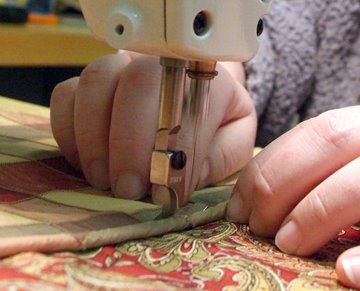For as long as I can remember; and probably as long as my mother can remember – in short, a long, long time - roman shades have been fabricated using strings and cords. The problem: exposed cords and strings present a strangulation hazard.
Change is always good. Anytime I dug in my heels and resisted, I’ve always been led to the same final conclusion: change is good! And so it is with the new shade safety standards. These standards have forced fabricators and manufacturers to go back to the drawing board, so to speak, and develop new ways to create and meet new safety requirements.
 |
| Source: Leatherwood Design Company Table & supplies set for new fabrication method to meet standards |
The standard affects YOU whether you are a workroom, designer, installer or touch Window Treatments in any way. No one gets a pass. There is no WAIVER. Standard must be followed. It doesn't matter if you are a company of ONE person, or a large multi national, you must follow the standard.In short, anyone along the supply chain of providing custom window treatments to clients must comply to new standards, copies of which can be found here:
- Read-only copy available (free) to the public on the WCAA website.
- For-purchase copies available on the WCMA sells copies.
In a nutshell, window treatments with exposed lift cords must not form a hazardous loop. It does NOT stipulate HOW to make the shade. It will tell you WHAT the OUTCOME must be. Want a visual? Here you go:
 |
| Source: Both images from Traditional Home, April, 2009 p.s. shades are not required to be automated, just so happens the ones on left are = compliant! |
This effects roman, austrian, balloon, london shades, etc., as well as italian-strung draperies and roller shades. I'm probably forgetting a few.... to make it easy, any cord - whether it be behind, in front or on the side of a window treatment; if it has a hazardous loop, it's not compliant. Simple as that.
Common Misconceptions:
The second big misconception is holding a belief that having a client/homeowner sign a waiver or disclaimer will protect you. Not advisable. Having a client sign any type of waiver or disclaimer - no matter what you may want to call it - says you knew it was a problem and did it anyway. It actually can do more harm than good, seen that you were aware that a threat/danger existed yet chose to sell anyway.
Finally, a third misconception, in my personal and individual opinion, is that this is only a concern for those who have small children in the home. Let's be realistic. Most homeowners have children who visit. Many also decide to re-sell their homes and a new homebuyer is likely to be one who has children. For these reasons, you can't predict whether or not a child will be at risk or not. For these reasons, I consider the standards to be critical for ALL clients, leading me to decide a year ago that I would only sell cordless shades.
Is it realistic to meet the new standards?
Yes, the standard is realistic. There are lots of ways to make a safe shade including cordless options. Many manufacturers have released fantastic new products and the custom workroom industry has also adopted many innovative methods for fabrication. [Focus of January 16, 2012 #customwrkrmchat, 9:30am ET].
 |
| Source: Storibook Designs Cordless, Custom Roman Shades |
 |
| Source: Leatherwood Design Company Backside view of two compliant fabrication methods |
- Stop selling any corded treatments! This is extreme but I guess for some this may be their alternative. It is not my choice. There are many new, exciting and creative alternatives available to offer clients.
- Motorization. Who doesn’t love a remote? Motorization is a convenient and safe option for lifting functionality.
- Retrofit. Retrofit kits are available (www.windowcoverings.org). This provides you with an opportunity to communicate with and educate past clients, providing them with a new alternative.
- Embrace the change & Expand Offerings. Design professionals can offer safety-audits to homeowners as a new service.
- Best bet: (IMHO) Know the standards and adopt new fabrication methods! As a homeowner, know the standards so that you can be sure you are putting the safest products in your home.
Please weigh in here too, by leaving a comment below. I'd love to hear your thoughts and questions on this issue.










Thanks for clarifying the details.
ReplyDeleteYears ago when my son was young, I went around and cut every loop on my shades to get rid of the hazard. Even on those shades that I didn't think he would be near, I didn't want to take the risk. You can't be too safe. I'm delighted it is the standard now.